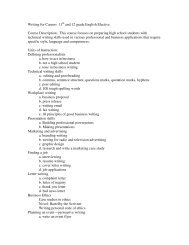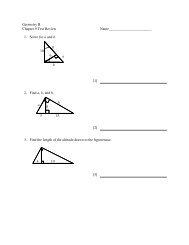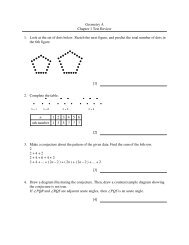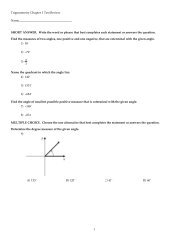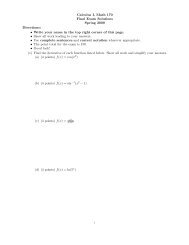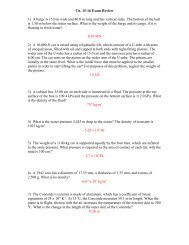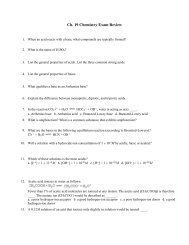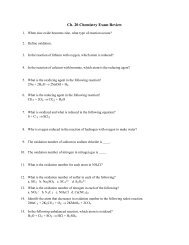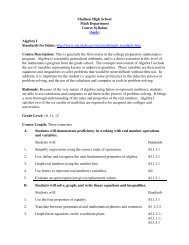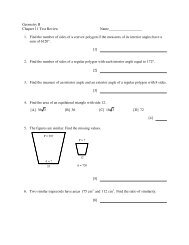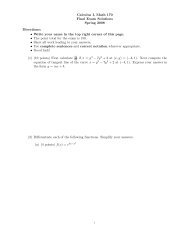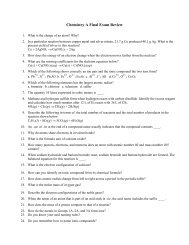Calculus I, Math 170 Final Exam Solutions Spring 2008 Directions ...
Calculus I, Math 170 Final Exam Solutions Spring 2008 Directions ...
Calculus I, Math 170 Final Exam Solutions Spring 2008 Directions ...
You also want an ePaper? Increase the reach of your titles
YUMPU automatically turns print PDFs into web optimized ePapers that Google loves.
<strong>Calculus</strong> I, <strong>Math</strong> <strong>170</strong><br />
<strong>Final</strong> <strong>Exam</strong> <strong>Solutions</strong><br />
<strong>Spring</strong> <strong>2008</strong><br />
<strong>Directions</strong>:<br />
• Write your name in the top right corner of this page.<br />
• The point total for the exam is 150.<br />
• Show all work leading to your answers.<br />
• Use complete sentences and correct notation wherever appropriate.<br />
• Good luck!<br />
(1) (10 points) First calculate dy<br />
dx if x = y3 − 7y 2 + 2 at (x, y) = (−4, 1). Next compute the<br />
equation of tangent line of the curve x = y 3 − 7y 2 + 2 at (−4, 1). Express your answer in<br />
the form y = mx + b.<br />
(2) Differentiate each of the following functions. Simplify your answers.<br />
(a) (4 points) f(x) = e 4x−x2<br />
1
(b) (6 points) g(t) = (3t 2 − 4t) ln(2t)<br />
(c) (6 points) F (x) = sin −1 (2x 3 − x)<br />
(3) (8 points) Use logarithmic differentiation to calculate the derivative of y = x ln x .<br />
(4) Find each of the limits<br />
√<br />
given below. If the limit does not exist, then state why. say so.<br />
x + 5 − 3<br />
(a) (4 points) lim<br />
x→4 x − 4
(b) (4 points) lim<br />
x→−2− x2 + 2x − 8<br />
x2 − 4<br />
(c) (4 points) Suppose that lim<br />
x→1 f(x) = 0 and that g is a function satisfying the condition<br />
|g(x)| ≤ 2 for all x = 1. Calculate lim<br />
x→1 f(x)g(x).<br />
(5) (4 points) On the given axes, sketch graphs of the functions described below.<br />
(a) a function that is continuous everywhere except at x = 3 but is continuous from the<br />
left at x = 3<br />
y<br />
x
(b) a function that is continuous but not differentiable at x = 1<br />
(6) Find the indefinite or definite integrals of each of the following:<br />
<br />
(a) (6 points)<br />
ln 4<br />
5x<br />
(1 − 2x2 dx<br />
) 2<br />
y<br />
e<br />
(b) (8 points)<br />
ln 2<br />
x + e−x ex dx; express your answer as a single logarithmic expression in<br />
− e−x exact form. Do not give a decimal approximation.<br />
x
(7) Two particles collide sending one particle north and the other west. The particle moving<br />
north is moving with a position function s(t) = 2t 3 − 14t 2 + 22t − 5 and the one moving<br />
west is given by d(t) = 4t 2 − 16t, t ≥ 0 with t in seconds. At t = 10:<br />
(a) (4 points) What are the velocities of both particles?<br />
(b) (8 points) At what rate are the particles moving away from each other? Make your<br />
answer accurate to two decimal points. Indicate the units in your answer.<br />
(c) (4 points) What is the acceleration of both particles?<br />
(d) (4 points) When does the velocity of the particle moving north change its sign (+/-)?
(8) (16 points) A cylindrical can with no top is to be made to hold 12 cm 3 of liquid. Find the<br />
dimensions of the can that will minimize the cost of the metal needed to make the can.
(9) A function F is defined on the interval [0, 4]; its derivative is F ′ (x) = e sin x − 2 cos(3x).<br />
With the use of a graphing calculator, answer the following questions.<br />
(a) (4 points) Sketch F ′ in the window [0, 4] × [−2, 5].<br />
(b) (2 points) On what interval is F increasing?<br />
4<br />
2<br />
-2<br />
-4<br />
-6<br />
2 4<br />
(c) (4 points) At what value(s) x, does F have a local maximum? Justify your answer.<br />
Show Text Objects<br />
(d) (4 points) How many inflection points does F have? Justify your answer.<br />
(e) (4 points) Given that F (0) = 0, find F (4) accurate to three decimal places.
(f) (2 points) How many points on the graph of F ′ in the interval (0, 4) satisfy the Mean<br />
Value Theorem? Explain your answer.<br />
(10) Let R be the region shown below in the first quadrant that is bounded by the graphs of<br />
y = cos x and y = sin x. Give exact answers, not decimal approximations, to each of the<br />
following questions.<br />
(a) (4 points) Find the area of R. 4<br />
5<br />
3<br />
2<br />
1<br />
R<br />
-2 2 4 6<br />
-1<br />
-2<br />
-3<br />
-4<br />
-5<br />
-6<br />
Show Objects<br />
(b) (6 points) Find the volume of the solid created by rotating R around the x-axis.
(11) Consider the differential equation y ′ = x(y − 1) 2 .<br />
(a) (4 points) On the axes provided, sketch a slope field for the differential equation at the<br />
2<br />
indicated points.<br />
3<br />
1<br />
-4 -2 2 4<br />
(b) (6 points) Find the particular solution y = -2f(x)<br />
to the differential equation with the<br />
initial condition f(0) = −1.<br />
(c) (4 points) What is the range of the solution found in part b)? Justify your answer.<br />
-1<br />
-3<br />
-4<br />
-5<br />
-6
(12) (6 points) Let f be a function that is defined on some interval containing a number a. Let<br />
L ∈ R. The truth of the sentence “lim f(x) = L” is defined as the truth of the following<br />
x→a<br />
implication: given any ɛ > 0, there exists a δ > 0 such that for any number x,<br />
0 < |x − a| < δ =⇒ |f(x) − L| < ɛ .<br />
Prove that lim<br />
x→2 (3x − 5) = 1 by showing directly that the above definition holds. In other<br />
words, using nothing more than elementary algebra, verify the definition.



